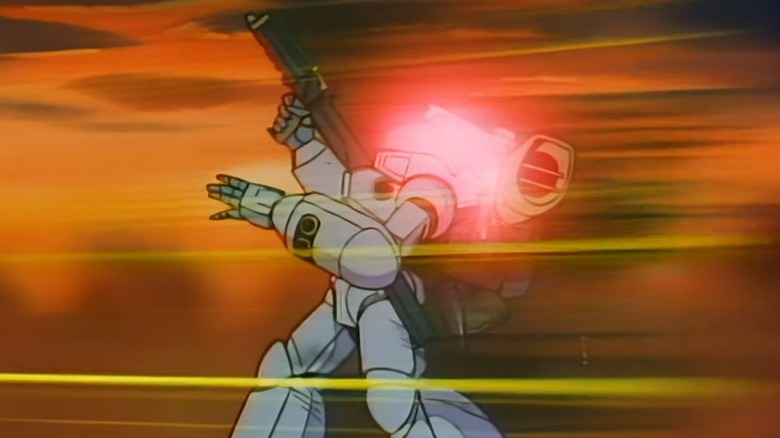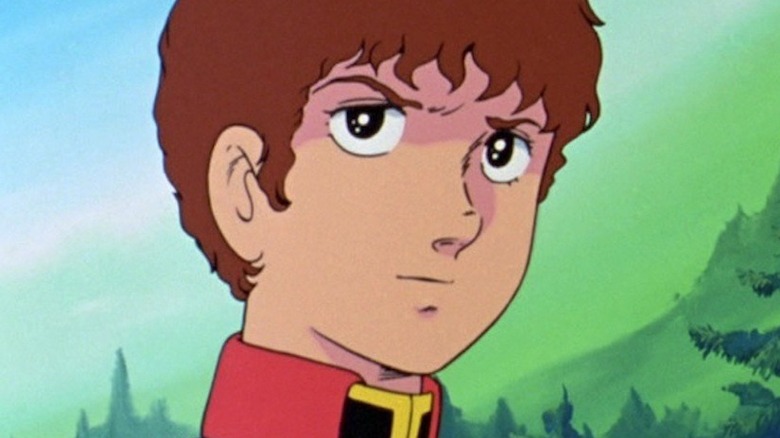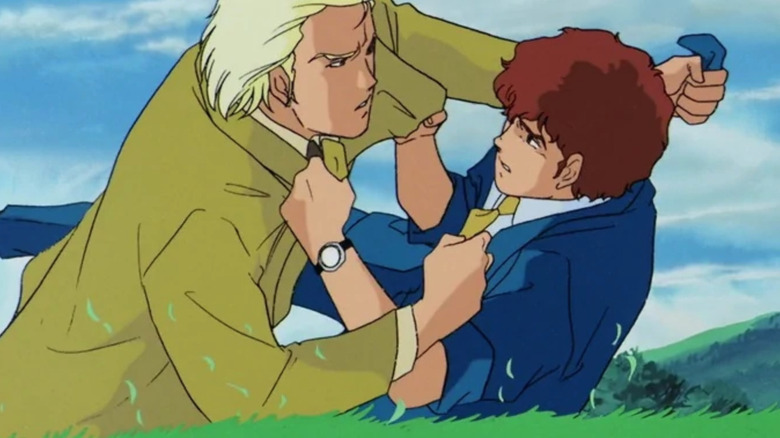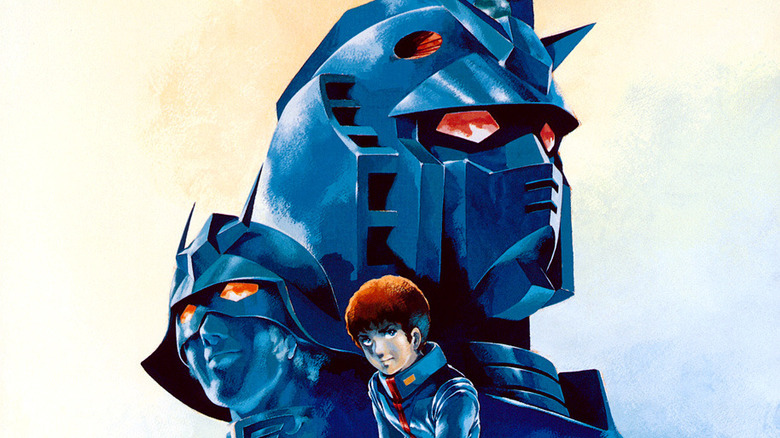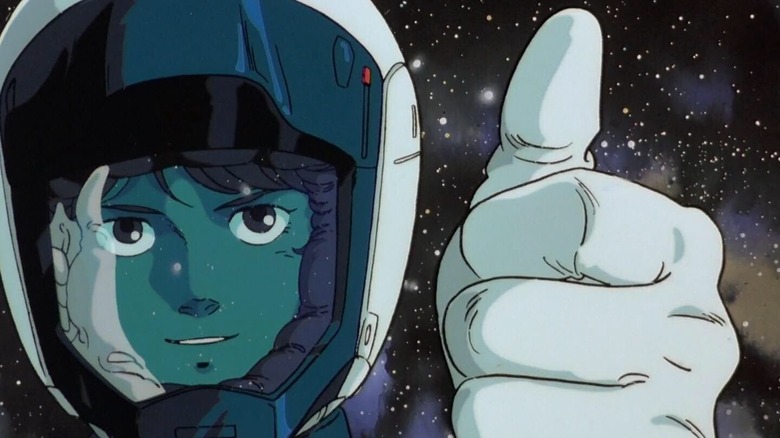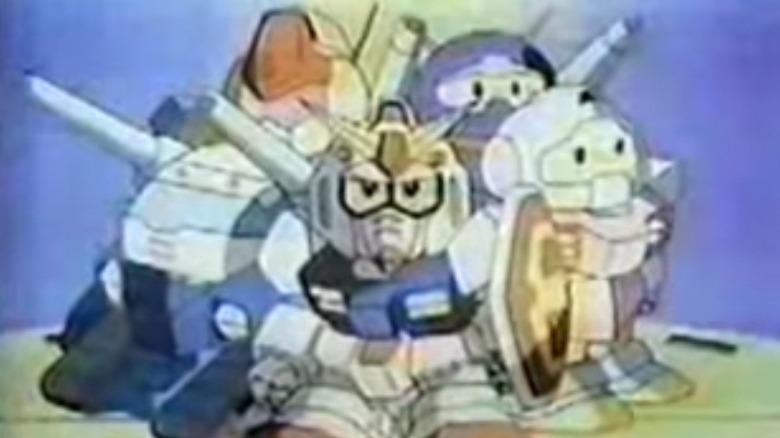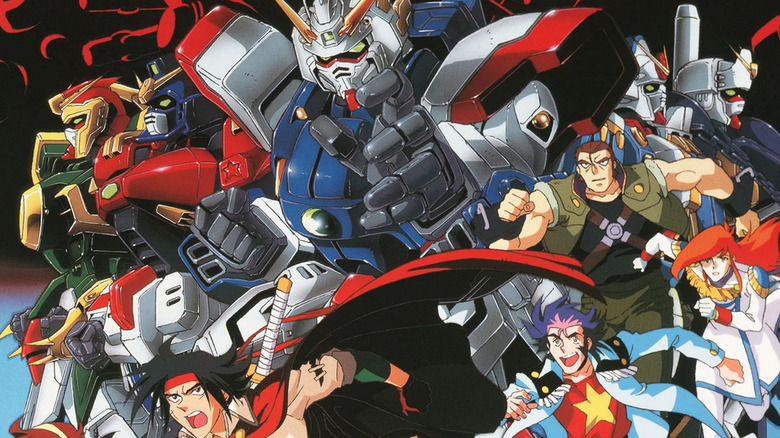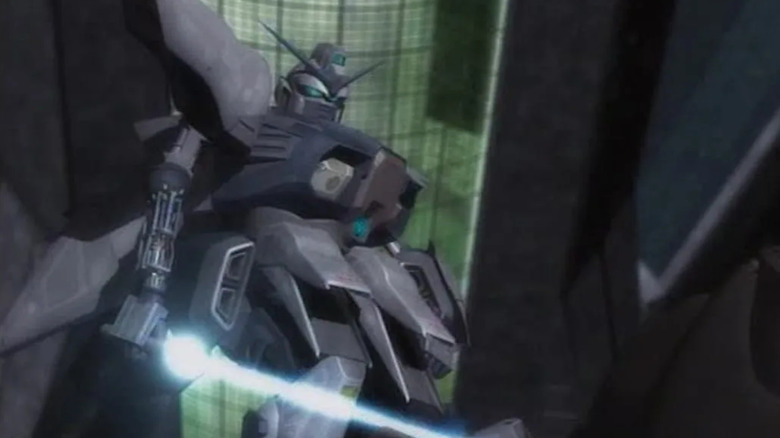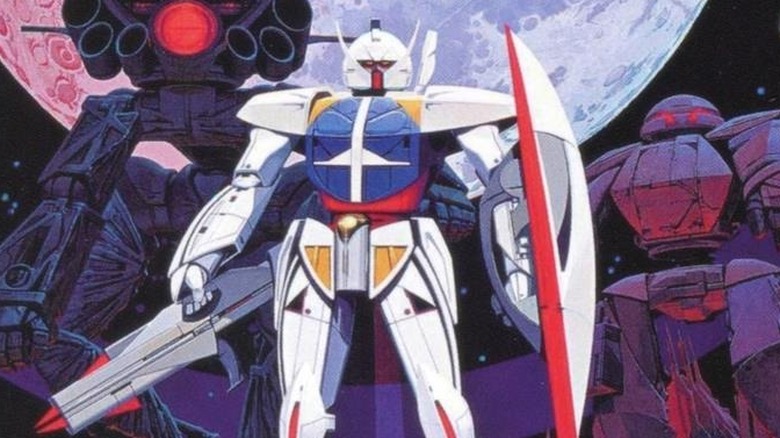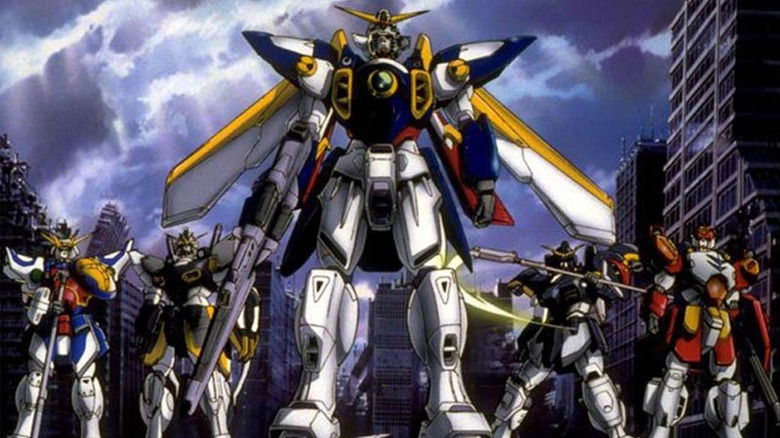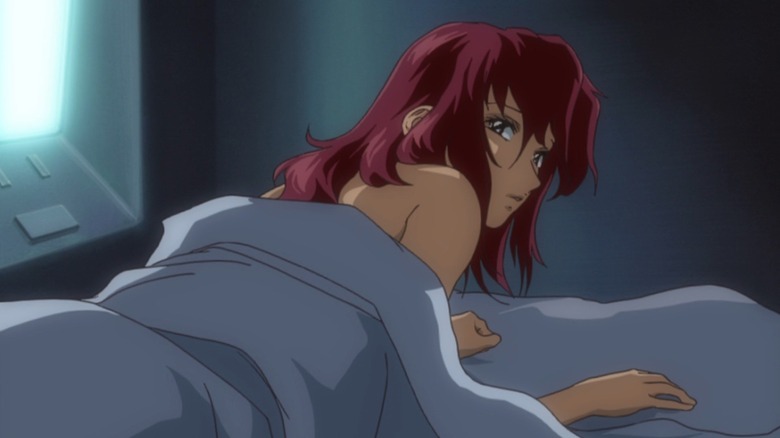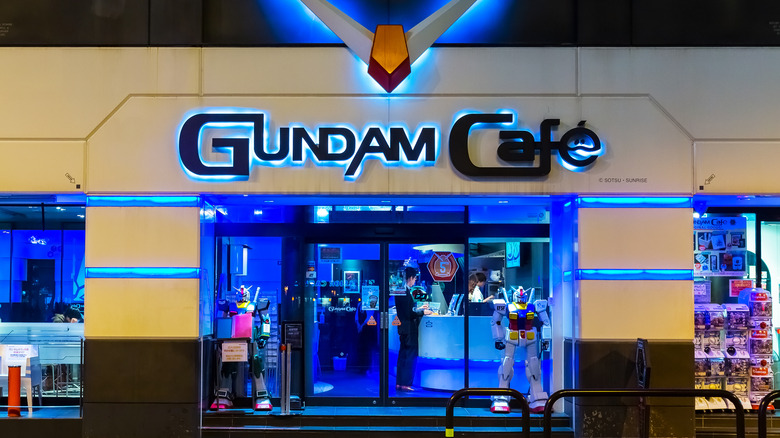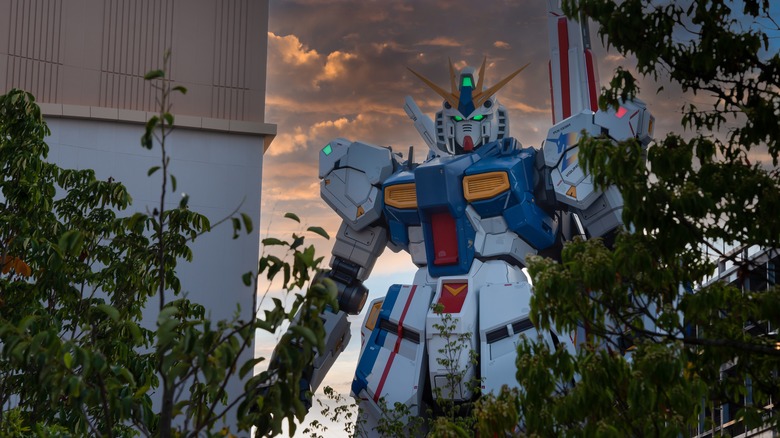The History Behind The Gundam Universe Is Even More Vast Than You Thought
You can't talk about the history of anime without talking about "Gundam." The influence of the original 1979 "Mobile Suit Gundam" TV series can be felt in almost every mecha series made since then. Even at times when the mecha genre has faded in mainstream popularity, the "Gundam" franchise is still going after more than four decades, with continuations of the original Universal Century timeline, a wide variety of alternate universe takes, and too many model kits to count.
Back when Yoshiyuki Tomino first created "Mobile Suit Gundam," this legendary success was far from something anyone could have expected. The production was a rough one, and it wasn't a success right off the bat but rather something that was gradually discovered and embraced by fans of all ages from all around the world. Here are some of the fascinating behind-the-scenes stories and other interesting factoids from the franchise's long history.
Mobile Suits were inspired by Starship Troopers
"Mobile Suit Gundam" is often credited with inventing the "real robot" sub-genre of mecha anime, aiming for greater scientific and political realism than the more fantastical "super robot" shows that preceded it. When it came to designing the series' iconic Mobile Suits, the artists looked to influences outside the world of anime. In particular, the 1959 Robert Heinlein novel "Starship Troopers" and its power armor suits were a major design influence.
Kazutaka Miyatake and Naoyuki Katoh of Studio Nue illustrated the Japanese translation of Heinlein's controversial militaristic sci-fi classic in the 1970s. Their designs were later used for model kits and a 1988 "Starship Troopers" anime adaptation. Miyatake described his design process for the illustrations to Forbes, building off Heinlein's descriptions of the armor as akin to an "iron gorilla."
However, the origins of the iconic Mobile Suits are not so simple. In fact, mecha designer Kunio Okawara explained to Forbes that he redesigned the Guncannon Mobile Suit from Miyatake and Katoh's designs. Beyond that, Miyatake says that his "Starship Troopers" art was only an influence and he was never directly involved in the production of "Mobile Suit Gundam."
Amuro died in the novelization
In 1979, "Mobile Suit Gundam" was a failure, doing so poorly in the ratings that the original 52-episode proposal was cut down to just 43 episodes. Nobody was expecting this to become a long-running franchise with countless sequels, spinoffs, and adaptations, so when Yoshiyuki Tomino got the chance to write a trilogy of novelizations of the original series, he was expecting this to be his final word on the One Year War (via Forbes). This sense of finality led to some significant changes – including the death of protagonist Amuro Ray!
In the novel trilogy, Ray is killed in the climactic battle of A Baoa Qu. Following his death, Char Aznable and the crew of the White Base team up to attack Side 3 and kill Gihren Zabi. When more "Gundam" anime finally got greenlit off the strength of model kit sales, the novel's ending was decidedly ignored so that Amuro could return. Some fans have claimed that the darker ending from the novels was Tomino's original plan for the anime, but there are no official sources for this interpretation.
The sexual undertones of Char and Amuro's relationship were intentional
The first episode of "Mobile Suit Gundam: The Witch from Mercury" caused quite a stir when it concluded with female protagonist Suletta Mercury engaged to another girl, Miorine Rembran. While the 2022 series may be the most explicitly queer "Gundam" series yet, the franchise has a long history of coded homoeroticism, going all the way back to the original Universal Century era enemy duo of Amuro Ray and Char Aznable.
As reported by Anime News Network, the "M.S. Gundam Fan Club Char's Counterattack" book includes an interview with Tomino saying that the intense, combative relationship between Amuro and Char in the 1988 "Mobile Suit Gundam: Char's Counterattack" movie had sexual undertones. These undertones were played up, the director said, "to the degree that you might wonder whether the two of them are homosexual."
Given just how much fan art and fan fiction has been made about Char and Amuro, it's clear a lot of viewers got the intended message. Boys Love shipping has played a significant role in the fandoms of various other "Gundam" series — the pretty boys of "Mobile Suit Gundam Wing" and "Mobile Suit Gundam SEED" were particularly popular for same-gender shipping (via AnimeNation).
The character designer distanced himself from the sequels
As a franchise handling the challenging double task of telling serious stories about the horrors of war while also selling toys of its robot weapons, there's always been debate about how effective "Gundam" has been at delivering its intended messages. From the perspective of one of the original series' key creatives, character designer and animation director Yoshikazu Yasuhiko, the various "Mobile Suit Gundam" sequel series have missed the mark at capturing the intentions of the original.
In a 2020 interview with Asahi Shimbun Digital translated by Crunchyroll, Yasuhiko said the original's focus on the "small people" caught up in war got abandoned in favor of increasing focus on the psychic Newtypes. "The element of 'Newtype' became more important in the following series," he argued. "Human innovation = Newtype will change the world. More and more otaku and critics who misunderstood that that was the theme of 'Gundam' started appearing. In fact, some of the sequels were produced to be interpreted that way. However, that is elitism."
Emphasizing how dangerous this "elitism" could be, Yasuhiko noted the similarities between the ideology around the Newtypes and that of the Aum Shinrikyo cult that attacked the Tokyo subway system with sarin gas in 1995. He wrote the "Mobile Suit Gundam: The Origin" prequel manga as a corrective to the ways he felt the franchise had gone astray. Yasuhiko would also direct the 2022 feature film "Mobile Suit Gundam: Cucuruz Doan's Island," based on a banned episode.
Zeta Gundam has a confirmed autistic hero
The list of anime characters actually confirmed to be on the autism spectrum is almost nonexistent. While there are a few educationally-oriented mangas on the subject, such as "With the Light: Raising an Autistic Child" by Keiko Tobe and "My Brain is Different: Stories of ADHD and Other Developmental Disorders" by Monzusu, this aspect of mental health remains relatively unexplored in the medium. That said, the most famous, canonically autistic character in anime is Kamille Bidan, the protagonist of "Mobile Suit Zeta Gundam."
In Episode 9 of "Mobile Suit Zeta Gundam," Kamille directly self-identifies as "an autistic child," something very unusual for a TV series from 1985. It must be said that Tomino had some inaccurate understandings about autism in relation to Kamille, specifically his claims in a 1994 interview with Anno that people "become" autistic rather than being born as such. Despite these problems, some viewers have found Kamille a compelling and relatable character, with the double-edged sword of his Newtype abilities being an effective metaphor for those who feel intense emotional empathy but struggle to understand social situations.
Doozy Bots, the failed American pilot
Long before Toonami introduced "Mobile Suit Gundam Wing" to American kids in 2000, Sunrise had a much less successful plan to bring "Gundam" to the United States. Specifically, the plan was to bring the cutesy and hyper-merchandisable "SD Gundam" characters to America in a new cartoon using the same designs but otherwise sharing nothing in common with any of the "Gundam" anime. The result was "Doozy Bots."
A trailer produced in 1989 claimed the show was set for release in 1991, but "Doozy Bots" ultimately never made it to air – which was almost certainly for the better, given how comically terrible the trailer is. Everything about this adaptation, from the obnoxious theme music and awful voice acting to the villains trying to "rob the world of fun" with a robot turkey sidekick, feels almost like a parody of the silliest mediocrities of '80s television animation. There aren't many intentional jokes that are funnier than the narrator describing this as "beautifully animated."
G Gundam changed everything to boost toy sales
In the early '90s, "Gundam" toy sales were declining. 1993's "Mobile Suit Victory Gundam" was theoretically meant to appeal to kids with its younger protagonist, but the story's depressing tone and high body count made it decidedly controversial. In a 2002 talk at Georgia State University (via Animefringe), director Yasuhino Imagawa explained that the sponsors were only willing to give the "Gundam" franchise one more chance following "Mobile Suit Victory Gundam" to prove it was still relevant in the marketplace. Imagawa achieved this with 1993's "Mobile Fighter G Gundam."
"Mobile Fighter G Gundam" was a serious change of pace from the "Gundam" norm by being much less serious than any previous "Gundam" TV series. Instead of being set in the Universal Century, it takes in an alternate timeline known as the Future Century. The Gundams don't fight in wars but rather in an international "Gundam Fight" tournament. Each of Earth's nations is represented by a Gundam (generally involving comedic stereotypes), and whichever country has the winning fighter gets to control the world government for four years. The resulting anime is one closer in spirit to classic "super robot" anime and traditional fighting shonen than to the Universal Century stories.
G-Saviour, the forgotten live-action movie
Hollywood has had its sights on "Gundam" since 1983, when screenwriter Chip Proser, concept artist Syd Mead, and the computer effects team behind "The Last Starfighter" worked on an ultimately unproduced live-action "Gundam" film. The RX-78-2 Gundam cameoed in Steven Spielberg's 2018 movie "Ready Player One." Also in 2018, Legendary Pictures announced it had the rights to develop a "Gundam" movie, and in 2021 Netflix acquired the distribution rights when Jordan Vogt-Roberts was brought on to direct.
What many casual fans might not realize, however, is that there already is a live-action, English-language "Gundam" movie — but people don't really talk about it. "G-Saviour," a co-production between Sunrise and the Canadian production company Polestar Entertainment, was a made-for-TV movie granted a theatrical release in Japan to celebrate the "Gundam" franchise's 20th anniversary in 1999. Though set in the Universal Century continuity, the filmmakers were reportedly given little information about the series' history. Though some critics gave it surprisingly positive reviews, others absolutely hated it, and the audience reception was generally poor.
Blade Runner's Syd Mead designed Turn A Gundam
Syd Mead was one of the greatest industrial designers and science fiction artists, responsible for conceptualizing the worlds and technology of the "Blade Runner" movies, "Aliens," and "TRON." His first brush with "Gundam" was on the abandoned 1983 live-action movie adaptation. In 1999, he got the chance to lend his distinctive style to an actual completed "Gundam" anime — "Turn A Gundam."
The first "Gundam" series directed by Tomino since "Mobile Suit Victory Gundam," "Turn A Gundam" was made to celebrate the franchise's 20th anniversary and merge all the preexisting "Gundam" timelines into a single unified continuity. The "Mead Gundam" art book credits Mead with designing seven Mobile Suits, six of which appear in the anime. His sleek, rounded style was a departure from the norm for "Gundam." The titular Mobile Suit, the System-∀99 ∀ Gundam, is the closest in appearance to any of the classic "Gundam" designs, but with its own quirky flavor (yep, the robot has a mustache).
Why Cartoon Network stopped airing Gundam
When "Mobile Suit Gundam Wing" premiered on Cartoon Network's Toonami block in 2000, it seemed like it could be the next big thing. Airing in edited form after school and uncensored at midnight, it was a major hit with an older teenage crowd than was typically watching Cartoon Network back in the day. No other "Gundam" series, however, matched its success on Toonami.
Toonami's co-creator Jason DeMarco has stated on Twitter that he wanted to follow up "Mobile Suit Gundam Wing" with some of the other '90s series like "After War Gundam X" and "Turn A Gundam," but that the licensors were insistent on them airing the original "Mobile Suit Gundam" instead. The dated '70s animation was a hard sell for the younger crowd. If that wasn't enough of a problem, 9/11 happened midway through its run, making the network uneasy about airing a war drama. The show was temporarily pulled and ultimately moved to the new Adult Swim block.
From there, momentum for the franchise mostly stalled out, with "Mobile Suit Gundam SEED" in 2004 being the last "Gundam" show to air on the original Cartoon Network Toonami block. Since its 2012 resurrection on Adult Swim, Toonami has aired multiple newer "Gundam" series such as "Mobile Suit Gundam: Iron-Blooded Orphans" and the TV versions of the "Mobile Suit Gundam Unicorn" and "Mobile Suit Gundam: The Origin" OVAs.
Multiple series got parental complaints
Who is "Gundam" for? That's a complicated question to answer. Some installments, like "SD Gundam" and "Gundam Build Fighters," are clearly aimed at kids, while most modern Universal Century series are intended for the adult fans of the originals. As such, the "Gundam" anime in the middle of this maturity range, broadcast in the evening and geared towards a teenage audience, have a tendency to cause controversy over their content.
One infamous example of parental outcry in 2003 was over Episode 16 of "Mobile Suit Gundam SEED," in which the series' protagonist Kira Yamato is implied to have had sex with Flay Allster (via Anime News Network). Though nothing graphic was shown, the Mainichi Broadcasting station was compelled to issue a statement on the content having deserved more careful consideration. Playing off the controversy, the actual sex scene was animated and included in the "Mobile Suit Gundam SEED: Special Edition" movie trilogy.
Still, sexual content is pretty rare in "Gundam." Intense violence is far more common throughout the franchise, but even though this violence is expected, that hasn't stopped parental complaints. A 2015 complaint about violence on television singled out a mecha anime where "several nonresistant prisoners and enemy soldiers are gunned down by the young male protagonist," which was almost certainly referring to "Mobile Suit Gundam: Iron-Blooded Orphans." "If you look at the title," the complaint alleged, "one would immediately think of this as a children's show and that many children would be watching."
Gundam Cafes existed in Japan from 2010-2022
There are tons of anime receive themed pop-up cafes in Japan, but relatively few anime are successful enough to warrant a full-on permanent cafe. The first Gundam Cafe opened in the otaku mecca of Akihabara in 2010, serving meals and drinks inspired by the various "Gundam" anime as well as selling merchandise (via Screen Rant). More branches opened up over the next decade in Japanese cities such as Odaiba, Fukuoka, and Yokohama.
Unfortunately, like many businesses, the Gundam Cafe chain became a casualty of the COVID-19 pandemic. The Akihabara restaurant's massive expansion in 2020 was unfortunately timed, to say the least, and on November 1, 2021, it was announced all the Gundam Cafes would be closing in the early months of 2022 (via Japan Today). One source of hope for those who still wish to dine like a robot pilot — the closure announcement ended with the words, "Please look forward to our next project," so a similar restaurant could be in the works.
Tomino apologized for Reconguista in G
The 2014 series "Gundam Reconguista in G," referred to as "G-Reco" for short, was the first "Gundam" TV anime to be written and directed by franchise creator Yoshiyuki Tomino since "Turn A Gundam" concluded in 2000. While Tomino stayed involved in the franchise, in the intervening 14 years, he also worked on compilation movies for "Turn A" and "Zeta Gundam" as well as the "Ring of Gundam" CG short film, he remained absent from the many the mainline "Gundam" projects. While Tomino's return may have seemed like a cause for excitement, it ended up being a cause for disappointment as its mediocre ratings on IMDb and MyAnimeList attest to — "G-Reco" was not a well-liked series.
The most common criticism was that the storytelling was incomprehensible. Even other anime creators like Studio Gainax co-founder Toshio Okada took aim the series apart for how confusing it was. Tomino ultimately acknowledged and apologized to his critics. In the June 2015 issue of "Gundam Ace" magazine, he said, "If I was told that it wasn't understandable because I was bad, all I could say is, 'I'm sorry.'" Tomino got a second chance to tell the "G-Reco" story with greater coherence in a five-part movie series released between 2019 and 2022.
Proposals to build Gundams in real life
As technology advances, there's always a curiosity about which elements from science fiction will end up becoming science facts. Will we ever have Gundams in real life? In 2012, Japan's Liberal Democratic Party reportedly considered building real-life Gundams, which, if directly comparable to those in the anime, would cost around $725,000,000 per unit (via Kotaku). In 2017, however, it was confirmed that the Ministry of Defense's "Gundam" program was just a marketing term for developing technologically-enhanced uniforms for soldiers rather than anything resembling a full-scale Mobile Suit (via Anime News Network).
While functional Mobile Suits are still just a pipe dream, multiple life-size Gundam statues have been made. The first of these was a model of the RX-78 Gundam, which stood in Odaiba from 2009 to 2017 before being replaced by an even bigger RX-0 Unicorn statue, the head of which is able to transform like that in the anime. The RX-78 model introduced in 2020 in Yokohama is even more impressive, with multiple moving parts (it is on display through 2023). Other to-scale Gundam statues include the RX-93 ν Gundam in Fukuoka and the ZGMF-X10A Freedom Gundam in Shanghai.

